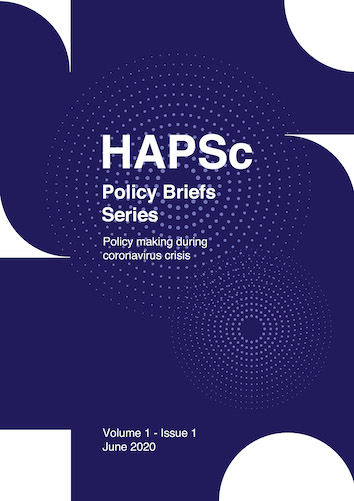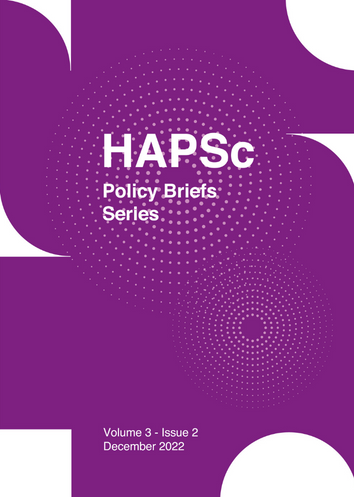Effects of Policy Responses to the Spread of Covid-19 Pandemic
Abstract
Covid-19 is a new invisible threat that has affected almost all countries of the world. In this paper we study the effects of policy responses to the spread of coronavirus pandemic. For this purpose, we utilized the dataset of Oxford Coronavirus Government Response Tracker (OxCGRT) and we examined the correlation of policies with the number of daily coronavirus cases in five countries (Greece, Italy, Spain, Sweden and United Kingdom). In order to achieve that, we calculated Kendall Correlation Coefficient and Spearman Correlation Coefficient as well as p-value for the statistical importance of our data. Our results indicate that the policies have a direct impact on the spread of Covid-19.
Article Details
- Zitationsvorschlag
-
Briola, H., & Briola, K. (2020). Effects of Policy Responses to the Spread of Covid-19 Pandemic. HAPSc Policy Briefs Series, 1(1), 37–44. https://doi.org/10.12681/hapscpbs.24946
- Rubrik
- Articles

Dieses Werk steht unter der Lizenz Creative Commons Namensnennung 4.0 International. Authors retain copyright and grant the journal right of first publication with the work simultaneously licensed under a Creative Commons Attribution License that allows others to share the work with an acknowledgement of the work's authorship and initial publication in this journal.
Downloads
Keine Nutzungsdaten vorhanden.
Literaturhinweise
Ai, S., Zhu, G., Tian, F., Li, H., Gao, Y., Wu, Y., Liu, Q. and Lin, H. (2020). Population movement, city closure and spatial transmission of the 2019-nCoV infection in China, medRxiv 2020.02.04, 20020339.
Asian Development Bank (2020). Asian Development Outlook (ADO) 2020: What Drives Innovation in Asia?. Asian Development Outlook, Philippines.
CCSA (2020). How COVID-19 is changing the world: a statistical perspective. UNCTAD.
Dahiru, T. (2008). P-Value, a true test of statistical significance? a cautionary note. Annals of Ibadan Postgraduate Medicine, 6(1): 21-26.
Domanović, D. (2020). Coronavirus disease 2019 (COVID-19) and supply of substances of human origin in the EU/EEA. European Centre for Disease Prevention and Control, Stockholm.
Fang, Y., Nie, Y. and Penny, M. (2020). Transmission dynamics of the COVID‐19 outbreak and effectiveness of government interventions: A data‐driven analysis, Journal of Medical Virology, 92 (6): 645-659.
Hale, T., Webster, S., Petherick, A., Phillips, T. and Kira, B. (2020). Oxford COVID-19 Government Response Tracker. Blavatnik School of Government.
Jarvis, C., Zandvoort, Van K., Gimma, A., Prem, K., Klepac, P., Rubin, G. and Edmunds, W. (2020). Quantifying the impact of physical distance measures on the transmission of COVID-19 in the UK, BMC Medicine, 18: 124.
Jüni, P., Rothenbühler, M., Bobos, P., Thorpe, K., Costa, da B., Fisman, D., Slutsky A. and Gesink, D. (2020). Impact of climate and public health interventions on the COVID-19 pandemic: a prospective cohort study, Canadian Medical Association Journal, 192 (21): E566-E573.
Taghrir, M. Akbarialiabad H. and Marzaleh, Ahmadi M. (2020). Efficacy of Mass Quarantine as Leverage of Health System Governance During COVID-19 Outbreak: A Mini Policy Review, Archives of Iranian Medicine, 23 (4): 265-267.
Taylor, J. M. G. (1987). Kendall's and Spearman's Correlation Coefficients in the Presence of a Blocking Variable, Biometrics, 43 (2): 409-416.
Yang, Z., Zeng, Z., Wang, K., Wong, S., Liang, W., Zanin, M., Liu, P., Cao, X., Gao, Z., Mai, Z., Liang, J., Liu, X., Li, S., Li, Y., Ye, F., Guan, W., Yang, Y., Li, F., Luo, S., Xie, Y., Liu, B., Wang, Z., Zhang, S., Wang, Y., Zhong, N. and He, J. (2020). Modified SEIR and AI prediction of the epidemics trend of COVID-19 in China under public health interventions, Journal of Thoracic Disease, 12 (3): 165-174.




